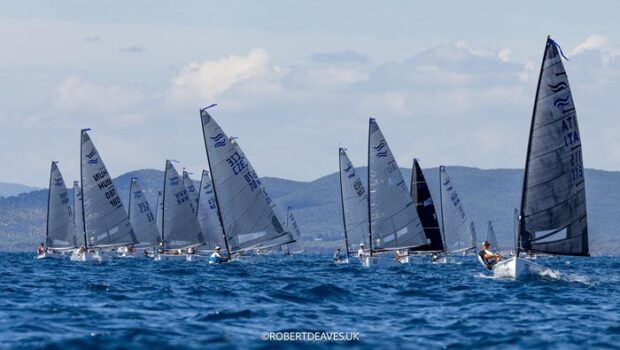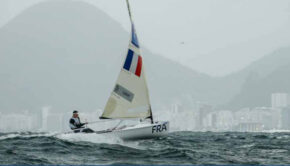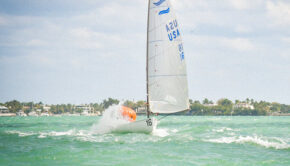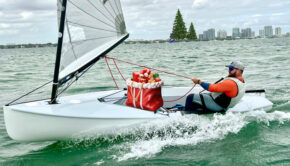Competing within the limits of the rules
Published on September 13th, 2024
The Racing Rules of Sailing state in rule 42 how “a boat shall compete by using only the wind and water to increase, maintain or decrease her speed. Her crew may adjust the trim of sails and hull, and perform other acts of seamanship, but shall not otherwise move their bodies to propel the boat.”
In this report by Chris Watts, he details how the Finn Class recently managed the ‘propulsion’ rule:
Over 20 years ago, the President of ISAF, now World Sailing, referred to a Finn sailing event as an Air Rowing competition and commissioned a group which contained at least two Finn sailors to come up with a solution to return it to a sailing competition.
This was the birth of Appendix P (on-the-water observers), which was introduced at a Southampton conference where a representative from each MNA was invited to run training sessions in their own country.
The Finn Masters adopted Appendix P for the first time at their Worlds in Cannes, when it was realised that having the jury afloat would mean protests under rule 42 (Propulsion) and possibly disqualifications, and taking a two-turns penalty, then called a 720, sounded a lot better.
Since then, the number of yellow flag penalties has dropped considerably as more and more sailors understood the limitations and the judges became more consistent in their judgements. Most of the recent Finn World Masters have included a short briefing on common breaches and the Class Website has also further guidance.
Good sailors will sail to the limit of the rules to be as fast as possible, and it is inevitable that they will occasionally go past the limit or even old habits click in when not concentrating, as it is only at big championships that they will meet on the water judging.
At the 2024 Finn World Masters (Punta Ala, Italy), only 16 yellow flags were given, which included three Finns being given a second penalty – remember that there were 285 Finns entered. No names!
I asked the judges at Punta Ala to pick one of the penalties they gave and to explain in detail as to why it was given with the purpose of illustrating the processes that are undertaken before making a decision.
The first principle is that no penalty will be given unless they can clearly explain to the sailor why it was given. Most of you took up this option either on the water or in the jury tent at the end of racing.
CASE 1
About 20 seconds before a light wind start, the helm moved to heel the boat to leeward and then brought the boat back upright to accelerate into a gap. He was then very static for about 15 seconds, maintaining position. Then he repeated the roll at the starting signal. So, repeated rolling in the same vicinity.
You only get one opportunity to bring the boat up to speed at the start, and it can be very tempting to repeat the roll in the same area.
CASE 2
There were a couple of cases of boats taking incomplete penalties. They did not complete the two-turn penalty, each turn including one tack and one gybe, as required by RRS 44.2.
In one instance, on a downwind leg a boat was penalised in accordance with P 1.2 (yellow flagged by the jury) for rocking. The wind was about 12 knots and the sea was choppy. The boat acknowledged the award of penalty. Though she was relatively clear of other boats, it took about 10 seconds before she commenced her penalty. Starting from port she tacked and gybed completing one turn. Continuing in the same direction she tacked a second time and sailed away to the mark. She did not gybe a second time, thus did not complete the second turn as required by RRS 44.2
The Jury further penalised the boat for her breach of RRS 44.2 by awarding DSQ in compliance with RRS P2.1.
This unfortunately can be quite common, there were five incidents of either an incomplete penalty, two turns, being taken or forgetting that at the second penalty you have to retire. A quick read of Appendix P will show you how getting the penalty wrong can be severe.
CASE 3
One of the long-term issues in the Finn Masters reappeared in two penalties.
Repeatedly pulling the mainsail in and out in a rhythmical manner that has nothing to do with change of speed or direction is not trimming and is called fanning, which is a kind of pump. There were two occasions where the helm could clearly be seen to be fanning the sail in and out, in and out, in and out almost to the rhythm of a ticking clock. The hand holding the mainsheet straight from the boom working in unison with the boom going in and out. There was no change in direction, no waves, no excuse for breaking the rule and so a yellow flag was given.
CASE 4
I do not have access to my written notes right now, but I do remember two Finns making the same mistake on the first day. We both watched both boats repeatedly attempting to surf down a small wave. All attempts were unsuccessful, so we penalized them after the third time. Here’s the applicable interpretation:
PUMP 8
A pull of any sail made to attempt to surf or plane when surfing or planing conditions are marginal is permitted even if the attempt is not successful.
If a boat repeats an unsuccessful attempt to plane or surf, she is in the yellow light area. A third consecutive unsuccessful attempt is prohibited.
There were three penalties given for unsuccessful pumping to promote surfing and one for repeated pumping whilst already surfing. A boat to be clear on this rule has to be seen rapidly accelerating down the face of a wave after the pump and then not pumping again until no longer surfing or planning. We will be watching the end of your boom and hand movements and be somewhere abeam of you to judge as to whether you are successful or not.








 We’ll keep your information safe.
We’ll keep your information safe.